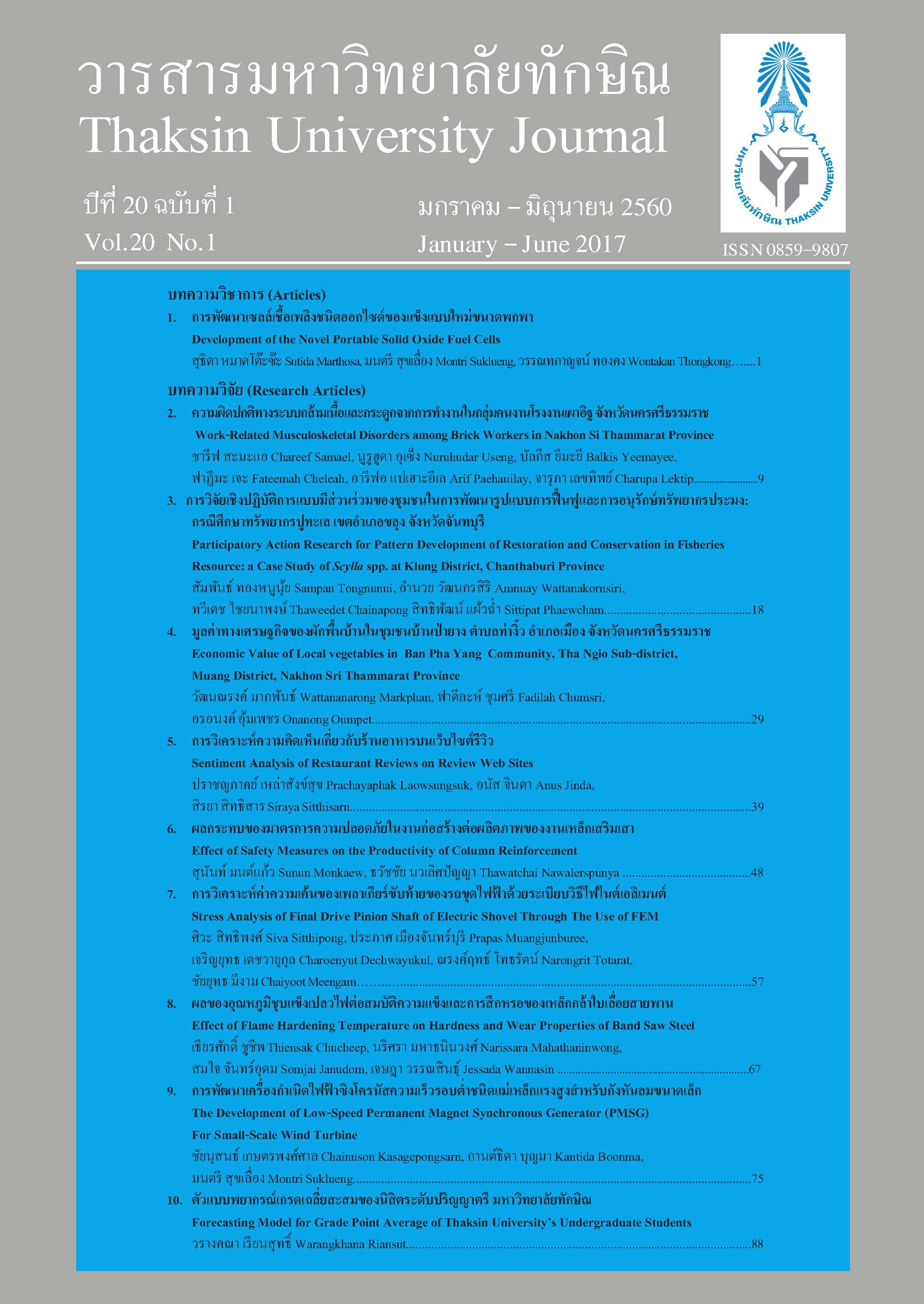Development of the Novel Portable Solid Oxide Fuel Cells
Main Article Content
Abstract
Fuel cell is an important alternative technology which is capable of overcoming energy shortage problem in the future. Solid oxide fuel cells use the abundant natural gas as fuel and they can be operated without the need of the expensive noble metal catalyst such as platinum; reducing the operating cost. The portable solid oxide fuel cells have been developed to produce power in a scale less than 1 kW. Researchers have produced the fuel cell stack with the peak power density of 348 mW cm-2. The power density was proportionally related to the operating temperature. There was an insignificant influence of the fuels (methane/air, propane/air and butane/ air) on the portable solid oxide fuel cells performance, in comparison to the influence of the operating temperature.
Article Details
References
[2] Larminie, J. and Dicks, A. (2000). Fuel cell systems explained (3rd Edition). United Kingdom: John Wiley.
[3] Marthosa, S. (2012). Improvement of electrocatalyst performance in hydrogen fuel cells by multiscale modelling.
Doctoral thesis. University of Manchester.
[4] Kwanmuang, S., Praneenararat, T., Piang-ngok, A. and Limsookniran, W. (2016). Fuel Cells: Energy for future.
Accessed by February 2016. From https://www.rmutphysics.com/physics/oldfront/97/fuelcell/fuel-cell.htm.
[5] Barbir, F. (2005). PEM Fuel Cells Theory and Practice. Elsevier Academic Press.
[6] Rousseau, S., Coutanceau, C., Lamy, C. and Léger, J.M. (2006). “Direct Ethanol Fuel Cell (DEFC):
Electrical performances and reaction products distribution under operating conditions with different
platinum-based anodes”, Journal of Power Sources. 158(1), 18-24.
[7] Antolini, E. (2007). “Catalysts for direct ethanol fuel cells”, Journal of Power Sources. 170(1), 1-12.
[8] Zhou, W.J., Song, S.Q., Li, W.Z., Zhou, Z.H., Sun, G.Q., Xin, Q., Douvartzides, S. and Tsiakaras. P. (2005).
“Direct ethanol fuel cells based on Pt/Sn anodes: the effect of Sn content on the fuel cell performance”,
Journal of Power Sources. 140(1), 50-58.
[9] Boonpasawai, S. (2005). Fuel cell and application of fuel cells in 21st century. Accessed by February 2016.
From https://design.ipst.ac.th/docu/photo/D006.pdf.
[10] Spacil, H.S. (1970). Electrical device including nickel-containing stabilised zirconia electrode. US Patent.
[11] Boer, Bd., Gonzalez, M., Bouwmeester, H.J.M. and Verweij, H. (2000). “The effect of the presence of fine
YSZ particles on the performance of porous nickel electrodes”, Solid State Ionics. 127, 269 - 276.
[12] Costa-Nunes, O., Gorte, R.J. and Vohs, J.M. (2005). “Comparison of the performance of Cu–CeO2–YSZ
and Ni–YSZ composite SOFC anodes with H2, CO and syngas”, Journal of Power Source. 141, 241 - 249.
[13] Mukundan, R., Brosha, E.L. and Garzon, F.H. (2004). “Sulfur tolerant anodes for SOFCs”, Electrochemical
Solid-State Letter. 7, (A5 - A7).
[14] Kao, W-X., Lee, M-C., Chang, Y-C., Lin, T-N., Wang, C-H. and Chang, J-C. (2010). “Fabrication and
evaluation of the electrochemical performance of the anode-supported solid oxide fuel cell with the
composite cathode of La0.8Sr0.2MnO3-Gadolinia-doped ceria oxide/La0.8Sr0.2MnO3”, Journal of Power Source.
195, 6468 - 6472.
[15] Veen, A.Cv., Rebeilleau, M., Farrusseng, D. and Mirodatos, C. (2003). “Studies on the performance stability
of mixed conducting BSCFO membranes in medium temperature oxygen permeation”,
Chemistry Communication. 9, 32 – 33.
[16] Jiang, S.P. (2008). “Development of lanthanum strontium manganite perovskite cathode materials of solid
oxide fuel cells: a review”, Journal of Material Science. 43, (6799 – 6833).
[17] Wincewicz, K.C. and Cooper, J.S. (2005). “Taxonomies of SOFC material and manufacturing alternatives”,
Journal of Power Source. 140, 280 - 296.
[18] Timakul, P. and Aungkavattana, P. (2007). Hydrogen and Fuel cells: New alternative energy for tomorrow.
Accessed by February 2016. From https://www.technologymedia.co.th/column/
columnview.asp?id=202.
[19] Wongvaranon, K. (2013). Fuel cell: Clean energy from hydrogen. Accessed by January 2016.
From https://www.dockyard.navy.mi.th/doced/Homepage/sontetset_files/varasan_dock56/18.pdf.
[20] Prommet, P. (2015). “The fuel cells alternative energy for the future”, Princess of Naradhiwas University
Journal. 7(2), 157-170.
[21] Protonex @ Ballard® company. (2016). Solid Oxide Fuel Cell Technlogy. Accessed by February 2016.
From https://www.protonex.com/technology/solid-oxide-fuel-cell/.
[22] Wang, Y.G., Sun, L.L., Luo, L.H., Wu, Y.F., Liu L.L. and Shi, J.J. (2014). “The study of portable direct-flame
solid oxide fuel cell (DF-SOFC) stack with butane fuel”, Journal of Fuel Chemistry and Technology.
42(9), 1135-1139.
[23] Kronemayer, H., Barzan, D., Horiuchi, M., Suganuma, S., Tokutake, Y., Schulz, C. and Bessler, G. (2007).
“A direct-flame solid oxide fuel cell (DFFC) operated on methane, propane and butane”, Journal of
Power Sources. 166(1), 120-126.
[24] Hao, Y., Shao, Z., Mederos, J., Lai, W., Goodwin, D.G. and Haile, S.M. (2006). “Recent advances in single-chamber
fuel-cells: Experiment and modeling”, Solid State Ionics. 177(19-25), 2013-2021.
[25] Gödickemeier, M. and Gauckler, L.J. (1998). “Engineering of solid oxide fuel cells with ceria-based
electrolytes”, Journal of The Electrochemical Society. 145(2), 414-421.
[26] Zhu, X., Wei, B., Lü, Z., Yang, L., Huang, X., Zhang, Y. and Liu, M. (2012). “A direct flame solid oxide
fuel cell for potential combined heat and power generation”, International Journal of Hydrogen
Energy. 37(10), 8621-8629.


